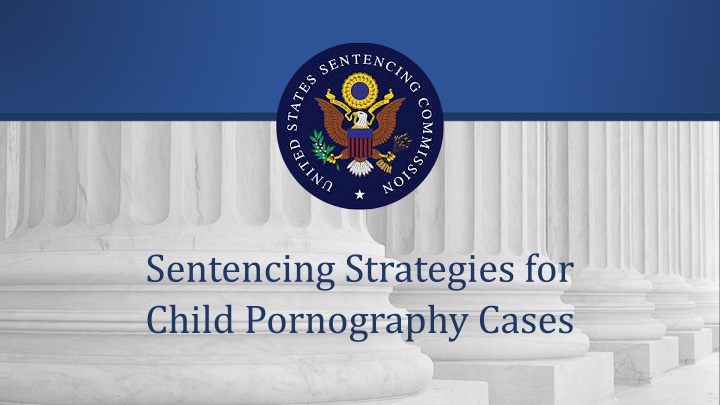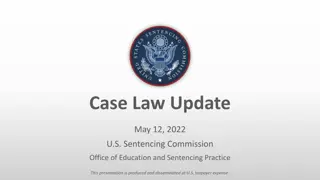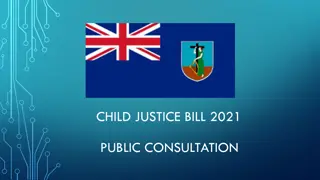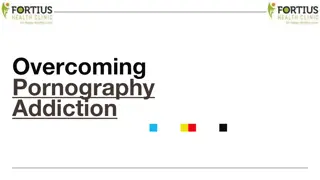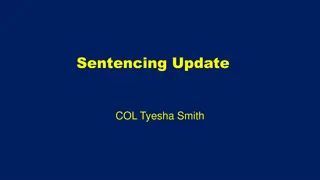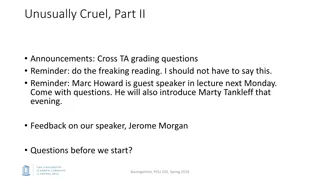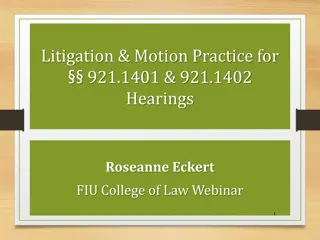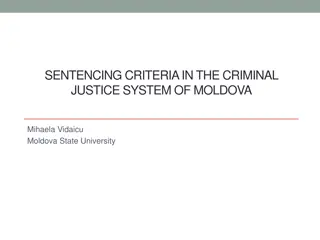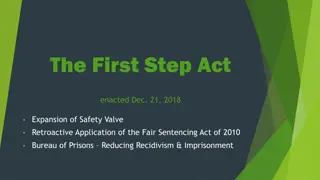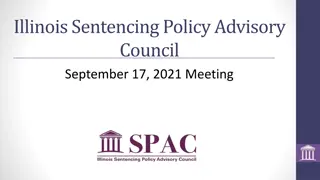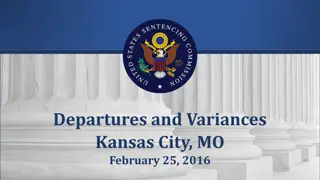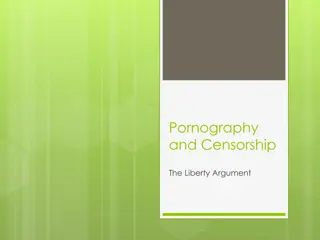Sentencing Strategies for Child Pornography Cases: Insights & Recommendations
Exploring sentencing strategies for child pornography cases, this resource delves into guidelines, departures/variances, restitution, and conditions of supervised release. It also discusses the offender profile, changes in penalty ranges, and average sentences. The content highlights how sentences have evolved over the years, stressi...
Download Presentation

Please find below an Image/Link to download the presentation.
The content on the website is provided AS IS for your information and personal use only. It may not be sold, licensed, or shared on other websites without obtaining consent from the author.If you encounter any issues during the download, it is possible that the publisher has removed the file from their server.
You are allowed to download the files provided on this website for personal or commercial use, subject to the condition that they are used lawfully. All files are the property of their respective owners.
The content on the website is provided AS IS for your information and personal use only. It may not be sold, licensed, or shared on other websites without obtaining consent from the author.
E N D
Presentation Transcript
Sentencing Strategies for Child Pornography Cases
2 Outline Resources Commission s 2012 Report to the Congress: Federal Child Pornography Offenses Departures/variances in child sex offenses Restitution in child pornography cases Conditions of supervised release
3 Resources www.ussc.gov (202) 502-4545 @theusscgov pubaffairs@ussc.gov
4 Commission s Website Sex Offense Primers Commercial Sex Acts & Sexual Exploitation of Minors Sexual Abuse & Failure to Register Offenses Also see: Departure & Variance Primer Statistical information
5 Commission s Website (cont.) U.S. Sentencing Commission s October 2009 The History of the Child Pornography Guidelines U.S. Sentencing Commission s February 15, 2012 Child Pornography Hearing transcript and written testimony
6 Commission s Website (cont.) U.S. Sentencing Commission s 2012 Report to Congress: Federal Child Pornography Offenses USSC Update: Recent Congressional Reports, May 2013 - the second half of this recorded webcast has an in-depth discussion of the Commission s child pornography Report to Congress
7 Selected Findings of the Commission s 2012 Child Pornography Report www.ussc.gov (202) 502-4545 @theusscgov pubaffairs@ussc.gov
Typical Child Porn Offender 8 Offender characteristics have changed little across time: White male U.S. citizen Educated Employed Early 40s Little/no criminal record
9 Sentences Guideline penalty ranges and average sentences have substantially increased, in part because of changes made by the PROTECT Act
Sentences 10 Average sentence lengths increased from 54 months in 2004 to 95 months in 2010 The rate of sentences within the guideline range decreased: 83.2% in FY04; 40.2% in FY10; and 32.7% in FY11 Lowest within-guidelines rate of any major offense type
11 Dangerous Behavior A significant percentage of non-production child pornography offenders have known histories of sexually dangerous behavior
12 Dangerous Behavior Criminal Sexually Dangerous Behavior (CSDB) Contact sex offenses Non-contact sex offenses Prior child pornography offenses (separated by an intervening arrest, conviction, or some other official intervention) Does not include non-criminal sexually dangerous behavior because it is not recorded consistently in presentence reports (PSR)
13 Dangerous Behavior Of the 1,654 2G2.2 cases, 520 (31.4%) involved either a prior conviction or a finding of CSDB in the PSR 581 including allegations Actual rate of CSDB is higher than known rate because child sex offenses are underreported
14 Known Recidivism General recidivism rate comparable to recidivism rate of all federal offenders
15 Known Recidivism Commission s study found that 30% of federal non- production child pornography offenders recidivated, although only 7% of them engaged in sexual recidivism Study of 660 offenders sentenced in FY99-00 followed for an average of 8 years Most offenders who recidivated did so within the first 36 months
16 Child Porn Report Takeaways The non-production child pornography guideline ( 2G2.2, the guideline for possession, receipt, and distribution of child porn) is outdated i.e., it does not account for recent technological changes in offense conduct The guideline does not reflect the variations in offenders culpability and sexual dangerousness
17 Takeaways (cont.) There is widespread inconsistent application of both 2G2.2 and the penal statutes carrying mandatory minimum penalties 2G2.2 produces overly severe sentencing ranges for some offenders and unduly lenient ranges for other offenders
18 Takeaways (cont.) Three primary sentencing factors best account for non- production offenders culpability and dangerousness: Content of offender s child pornography collection and the nature of an offender s collecting behavior Degree of an offender s involvement with other offenders in particular, in an Internet child pornography community Offender s history of engaging in sexually abusive, exploitative, or predatory conduct in addition to his child pornography offense
19 Takeaways (cont.) Three broad factors (content of collection, involvement in offender communities, and other sex offending) should be the primary considerations in determining the punishments imposed on child pornography offenders The guidelines should be amended to address these factors, and Congress should authorize the Commission to amend guideline provisions that were promulgated pursuant to specific congressional directives or legislation
20 Takeaways (cont.) Some recent studies indicate that psycho-sexual treatment may be effective in reducing recidivism for many sex offenders. Emerging research on the effectiveness of psycho-sexual treatment administered as part of the containment model is especially promising and warrants further study.
21 Departures and Variances www.ussc.gov (202) 502-4545 @theusscgov pubaffairs@ussc.gov
22 Factors Argued for Departures/Variances Psychosexual evaluations Risk of touching Length of time looking at child pornography Nature of images (e.g., very young children) Age of victims and the age of the defendant
23 Factors Argued for Departures/Variances Military Service Computer sophistication Experts Rehabilitation Physical condition of defendant
24 Policy Disagreement or Lack of Empirical Evidence Argument in Child Porn Cases Compare U.S. v Dorvee, 616 F.3d 174 (2d Cir. 2010) U.S. v. Grober, 624 F.3d 592 (3d Cir. 2010) U.S. v. Henderson, 649 F.3d 955 (9thCir. 2011) With U.S. v. Miller, 665 F.3d 114 (5thCir. 2011) U.S. v Bistline I, 665 F.3d 758 (6thCir. 2012) U.S. v. Muhlenbruch, 682 F.3d 1096, 1102 (8th Cir. 2012) U.S. v. Regan, 627 F.3d 1348, 1355 (10th Cir. 2010) U.S. v. Pugh, 515 F.3d 1179 (11thCir. 2008)
25 Restitution 18 U.S.C. 2259 www.ussc.gov (202) 502-4545 @theusscgov pubaffairs@ussc.gov
26 Restitution in Child Porn Offenses Paroline v. U.S., 134 S Ct. 1710 (2014) Restitution is proper under 2259 only to the extent the defendant s offense proximately caused a victim s losses. Applying the statute s causation requirements in this case, victims should be compensated and defendants should be held to account for the their conduct on those victims, but defendants should only be made liable for the consequences and gravity of their own conduct, not the conduct of others.
27 Restitution in Child Porn Offenses (cont.) Paroline v. U.S., 134 S Ct. 1710 (2014) There are a variety of factors, district courts might consider in determining a proper amount of restitution, and it is neither necessary nor appropriate to prescribe a precise algorithm for determining restitution. But district courts might, as a starting point, determine the amount of the victim s images, then set an award of restitution in consideration of factors that bear on the relative causal significance of the defendant conduct in producing those losses.
28 Restitution in Child Porn Offenses (cont.) Paroline v. U.S., 134 S Ct. 1710 (2014) 1. The number of past criminal defendants found to have contributed to the victim s general losses; 2. Reasonable predictions of the number of future offenders likely to be caught and convicted for crimes contributing to the victim s general losses; 3. Any available and reasonably reliable estimate of the broader number of offenders involved;
29 Restitution in Child Porn Offenses (cont.) Paroline v. U.S., 134 S Ct. 1710 (2014) 4. Whether the defendant reproduced or distributed images of the victim; 5. Whether the defendant had any connection to the initial production of the images; 6. How many images of the victim the defendant possessed and other facts relevant to the defendant s relative causal role.
30 Child Sex Crimes and Supervised Release www.ussc.gov (202) 502-4545 @theusscgov pubaffairs@ussc.gov
31 18 U.S.C. 3583(d) Conditions of Supervised Release Must be reasonably related to 18 U.S.C. 3553(a)(1), (a)(2)(B), (a)(2)(C), and (a)(2)(D) Cannot involve greater deprivation of liberty than is reasonably necessary to achieve the goals of (a)(2)(B), (a)(2)(C), and (a)(2)(D)
32 18 U.S.C. 3583(d) (cont.) Conditions of Supervised Release Specifically states that if an offender is required to register under SORNA, the court shall order compliance with SORNA requirements
33 Notice Requirement U.S. v. Rivera-Maldonado, 560 F.3d 16 (1st Cir. 2009) (failure to inform the defendant that he faced a possible life term of supervised release was plain error) U.S. v. Cope, 527 F.3d 944 (9th Cir. 2008) (court has discretion as to form or timing of notice, but court cannot announce the sentence and conditions and only afterward provide defendant an opportunity to object - here, remand was necessary because court failed to provide notice)
34 Notice Requirement (cont.) U.S. v. Wise, 391 F.3d 1027 (9th Cir. 2004) (where a condition of supervised release is not on the list of mandatory or discretionary conditions in guidelines, notice is required before it is imposed) U.S. v. Moran, 573 F.3d 1132 (11th Cir. 2009) (district court was not required to notify defendant before it imposed special conditions to address his proclivity for sexual misconduct)
35 Specific Conditions of Supervised Release for Sex Offenders www.ussc.gov (202) 502-4545 @theusscgov pubaffairs@ussc.gov
36 Specific Conditions of Supervised Release Total Ban on Internet Use U.S. v. Mark, 425 F.3d 505 (8th Cir. 2005) Internet use with USPO Approval U.S. v. Morais, 670 F.3d 889 (8th Cir. 2012) U.S. v. Demers, 634 F.3d 982 (8th Cir. 2011) U.S. v. Wiedower, 634 F.3d 490 (8th Cir. 2011) (vacating condition) U.S. v. Crume, 422 F.3d 728 (8th Cir. 2005) (vacating condition only possession and receipt)
37 Specific Conditions of Supervised Release No Contact with Minors U.S. v. Davis, 452 F.3d 991 (8th Cir. 2006) (no evidence that defendant had sexually abused a child so condition restricting access to daughter not reasonably related) Avoiding Locations with Minors U.S. v. Schaefer, 675 F.3d 1122 (8th Cir. 2012) (clear indication of intend to rebuild an inventory or child pornography) U.S. v. Ristine, 335 F.3d 692 (8th Cir. 2003) (condition not vague or overbroad)
38 Specific Conditions of Supervised Release Polygraph condition allowed U.S. v. Wiedower, 634 F.3d 490 (8th Cir. 2011) Mental Health treatment U.S. v. Wiedower, 634 F.3d 490 (8th Cir. 2011) Ban on Sexually Explicit Materials U.S. v. Deatherage, 682 F.3d 755 (8th Cir. 2012) (ban acceptable because likely abuse of children) U.S. v. Olsen, 667 F.3d 958 (8th Cir. 2012) U.S. v. Bender, 566 F.3d 748 (8th Cir. 2009)
39 Specific Conditions of Supervised Release Penile plethysmograph U.S. v. Dotson, 324 F.3d 256 (4th Cir. 2003) (acceptable condition) U.S. v. Medina, 779 F.3d 55 (1st Cir. 2015) (condition facially unreasonable) Abel Test (measure of visual reaction time ) Prescribed medication Occupational Restrictions U.S. v. Carter, 652 F.3d 894 (8th Cir. 2011)
